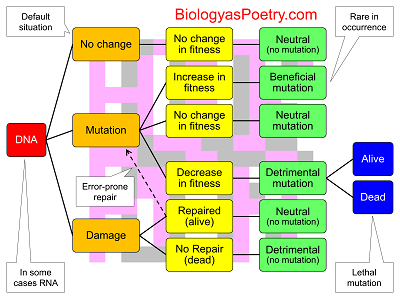∞ generated and posted on 2016.02.07 ∞
Replicable change in genotype.
| A mutation is when DNA is changed, but not so much that it no longer works as DNA, while the organism may end up working differently. |
Mutations represent changes in the sequence of bases making up hereditary material. Importantly, though, in most cases theses changes must be something that comes about by mechanisms other than solely due to intentionally undertaken recombination.
Mutations can include a switch in what base is present at a given position, a loss of one or more bases, a gain of one or bases, or, more rarely, a flipping in the order of bases. Mutations thus come in a variety of types including point, missense, nonsense, insertion, deletion, and frameshift mutations. Mutations also exist that are described as "silent".
Typically mutations occur due to processes and therefore have a stochastic (random) nature, that is, there will be some chance that a given mutation will occur in a given position within a genome and usually that will be fairly low. The likelihood of mutation, or mutation rate, can be a relatively fixed quantity for a given set of circumstances.
Mutations represent the ultimate source of genetic variation within populations. That is, mutations are how new alleles are formed. Note though that the term "mutation" can be used quite broadly in this sense to describe any form of replicable change in genotype, including those that stem from the recombination of sequence into new genetic loci.

Figure legend: Mutations versus nucleic acid damage and as considered as a function of fitness. Mutations can be replicated without repair whereas damages cannot, though in some cases damages can be repaired in ways that result in mutation (error-prone repair). Mutations can be beneficial, detrimental, or neutral to the carrying organism and its progeny. Of those three, beneficial mutations tend to be the rarest, though in part this is because for a beneficial mutation to truly be beneficial it literally must be better than all previous beneficial mutations that have occurred within a population at a given locus. Detrimental mutations may or may not be lethal, with mutations that kill their carrier obviously detrimental.
The idea of mutation is not identical to the idea of to . The distinction is made by the replicating (usually but not always DNA polymerase). That is, non-mutagenic replication results in no change in sequence from the parental genotype while mutations represent differences between the parental and daughter genotypes. Damages, unless repaired, in fact prevent formation of the daughter genotype altogether. Note that a consequence of nucleic acid damage nonetheless can be mutation, which can happen when damaging are mutagenically repaired, that is, .
From :
The occurrence of a given mutation is in no way related to the evolutionary needs of the particular organism or of the population to which it belongs. The precise results of a given selection pressure are unpredictable because mutation, recombination, and are making indeterminate contributions to the response to this pressure. All the steps in the determination of the genetic contents of a zygote contain a large component of this type of randomness. What we have described for mutation is also true for crossing over, …
The following video provides a brief as well as basic discussion of the diversity of origins of genetic variation in individuals:
This video (click here) involves a somewhat in-depth discussion of genetic variation in individuals as well as its prevalence in populations.